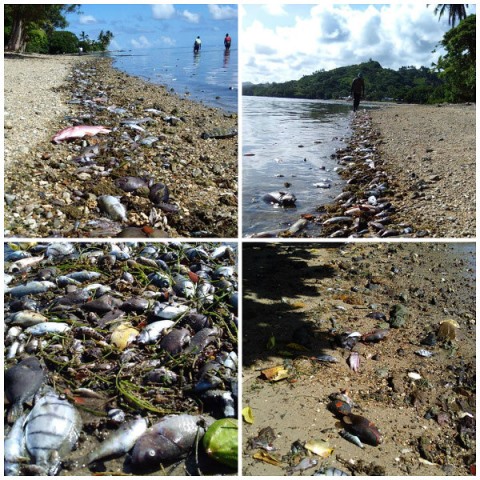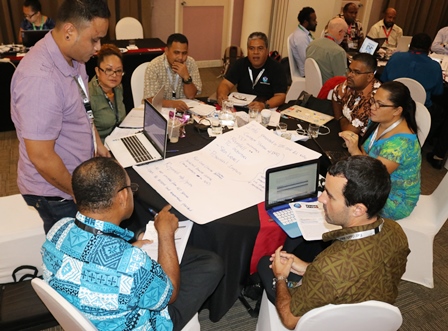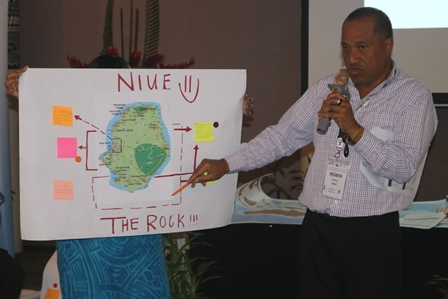
Climate Change Resilience
17 October 2016, Nadi, Fiji - ENSO, El Nino and La Nina are key meteorological terms that Pacific islanders will need to become more familiar with as their impacts reach into the daily lives and homes of island communities.
Over the next two days Pacific island Met workers are uniting with disaster management offices from across the region for the Second Pacific Islands Climate Outlook Forum (PICOF-2) to learn more of these climate phenomena and how the information can be best used to help prepare island communities.
 Image from Huffington Post, taken by Victor Bonito
Image from Huffington Post, taken by Victor Bonito
The El Nino period of 2015/2016 saw Samoa experience below average rainfall which led to sanitation issues, a meteorological drought was issued in September last year which saw an increase in the pink eye disease stemming from dust. In the Republic of the Marshall Islands (RMI), a State of Emergency was declared on 3 February, 2016, this was then elevated to a State of Disaster affecting 21,000 people in RMI costing the island nation 8.9 million USD in drought response measures. In Fiji, high temperatures were reached which saw dead fish washing up on the shores of the Coral Coast.
"It's important that our island communities know about these phenomena as they are the causes of the weather they experience at home, real impacts felt by us all, whether there is a drought or flooding, these two opposite extremes are felt differently within the Pacific islands," said Mr. Sunny Seuseu, of the Pacific Met Desk based at the Secretariat of the Pacific Regional Environment Programme (SPREP).
"The seasonal forecasts we as meteorologists provide people with, come at least three to six months in advance, this information will help you prepare for what may come, it serves as an early warning system. You can either save and collect water, coordinate national events, or prepare your homes, schedule your planting or harvesting – everything that you do as a Pacific islander."
ENSO is the El Nino Southern Oscillation and is the main driver of climate variability in the Pacific.
El Nino is abnormal warming of the central Pacific Ocean and is generally associated with below normal rainfall for the South-West Pacific. La Nina is the opposite of El Nino, it is an exceptional warming of the sea surface temperature of the South-West Pacific as well as a cooling of the central Pacific Ocean. This brings high rainfall to the west pacific while lower rainfall to the central and eastern Pacific countries.
When the Pacific region experiences either of these phenomena, the impacts in the Central to East Pacific are the opposite from that experienced in the West Pacific.
Day one of the PICOF-2 focussed on looking back at the El Nino 2015/2016 that started in June, 2015, peaked in October - this means that this was the period in which a lot of impacts were felt in the region, and ended in June 2016.

The effects of this throughout the Pacific region were identified by participants at the PICOF-2. Sessions throughout the day also saw Pacific met and disaster management staff identify what was forecasted, what information was shared from the met services on to sectors and how this was further communicated to audiences, and if there were any gaps.
Ultimately, bringing the two sectors together is to help improve the accuracy of the information available and the ways in which the information is shared so that Pacific islanders can prepare and respond.
For Niue the relationship between the Meteorological Office and the Niue Disaster Management Office is strong, with regular sharing of information which is then relayed to audiences in ways the community can understand.
The Niue Meteorological Office share daily bulletins twice a day, along with seasonal forecasts which are shared to the national radio and television station as well as to government departments including the Disaster Management Office. From that point the DMO then shares the information outlining the ways in which communities can prepare, or should best respond.
"While each community also receives the information from the Community Affairs, I also follow up with meetings with the village councils and NGO's with tips that best uses the information, for example during the dry season we strengthen the message of asking our communities not to light bush fires as the dangers that this can cause will be irreparable," said Mr. Robin Hekau, of the Niue Disaster Management Office.

"We also support our Niue Met Service by outlining that their information is the official information that we should be following. Through doing this consistently over the years, we have noticed a change in the behaviour of the local communities - people are now paying attention to our information and advice and they are responding accordingly."
Results from all input made at PICOF2 will be developed into a meeting report, also to be released at the end of PICOF2 is a Statement on Impacts and lessons learned from the 2015/2016 El Nino for Climate and Disaster Risk Management and outlook and preparations for the 2016/17 La Nina.
The Pacific Islands Climate Outlook Forum (PICOF-2) is held in Nadi, Fiji 17 - 18 October, 2016. It brings together national regional and international experts from the Meteorological Services Sector and the Disaster Risk Reduction, to provide a platform to consolidate seasonal forecasts from multiple sources to issue a consensus climate outlook for the Pacific region. This will include the presentation and discussion of the Tropical Cyclone outlook for the upcoming Season.
Partners supporting the PICOF2 are Secretariat of the Pacific Regional Environment Programme, World Meteorological Organisation, Environment and Climate Change Canada, United Nations Development Programme, Australian Bureau of Meteorology, Commonwealth Scientific and Industrial Research Organisation, Climate and Oceans Support Program in the Pacific, Government of Fiji – Fiji Meteorological Service, National Institute of Water and Atmospheric Research, National Oceanic and Atmospheric Administration, Pacific Meteorological Council, University of the South Pacific and the Government of the Russian Federation.
The PICOF-2 is undertaken with the financial support of the Government of Canada through the Federal Department of the Environment, financial contribution by the Government of the Russian Federation and the Government of Australia.
Over the next two days Pacific island Met workers are uniting with disaster management offices from across the region for the Second Pacific Islands Climate Outlook Forum (PICOF-2) to learn more of these climate phenomena and how the information can be best used to help prepare island communities.
 Image from Huffington Post, taken by Victor Bonito
Image from Huffington Post, taken by Victor Bonito The El Nino period of 2015/2016 saw Samoa experience below average rainfall which led to sanitation issues, a meteorological drought was issued in September last year which saw an increase in the pink eye disease stemming from dust. In the Republic of the Marshall Islands (RMI), a State of Emergency was declared on 3 February, 2016, this was then elevated to a State of Disaster affecting 21,000 people in RMI costing the island nation 8.9 million USD in drought response measures. In Fiji, high temperatures were reached which saw dead fish washing up on the shores of the Coral Coast.
"It's important that our island communities know about these phenomena as they are the causes of the weather they experience at home, real impacts felt by us all, whether there is a drought or flooding, these two opposite extremes are felt differently within the Pacific islands," said Mr. Sunny Seuseu, of the Pacific Met Desk based at the Secretariat of the Pacific Regional Environment Programme (SPREP).
"The seasonal forecasts we as meteorologists provide people with, come at least three to six months in advance, this information will help you prepare for what may come, it serves as an early warning system. You can either save and collect water, coordinate national events, or prepare your homes, schedule your planting or harvesting – everything that you do as a Pacific islander."
ENSO is the El Nino Southern Oscillation and is the main driver of climate variability in the Pacific.
El Nino is abnormal warming of the central Pacific Ocean and is generally associated with below normal rainfall for the South-West Pacific. La Nina is the opposite of El Nino, it is an exceptional warming of the sea surface temperature of the South-West Pacific as well as a cooling of the central Pacific Ocean. This brings high rainfall to the west pacific while lower rainfall to the central and eastern Pacific countries.
When the Pacific region experiences either of these phenomena, the impacts in the Central to East Pacific are the opposite from that experienced in the West Pacific.
Day one of the PICOF-2 focussed on looking back at the El Nino 2015/2016 that started in June, 2015, peaked in October - this means that this was the period in which a lot of impacts were felt in the region, and ended in June 2016.

The effects of this throughout the Pacific region were identified by participants at the PICOF-2. Sessions throughout the day also saw Pacific met and disaster management staff identify what was forecasted, what information was shared from the met services on to sectors and how this was further communicated to audiences, and if there were any gaps.
Ultimately, bringing the two sectors together is to help improve the accuracy of the information available and the ways in which the information is shared so that Pacific islanders can prepare and respond.
For Niue the relationship between the Meteorological Office and the Niue Disaster Management Office is strong, with regular sharing of information which is then relayed to audiences in ways the community can understand.
The Niue Meteorological Office share daily bulletins twice a day, along with seasonal forecasts which are shared to the national radio and television station as well as to government departments including the Disaster Management Office. From that point the DMO then shares the information outlining the ways in which communities can prepare, or should best respond.
"While each community also receives the information from the Community Affairs, I also follow up with meetings with the village councils and NGO's with tips that best uses the information, for example during the dry season we strengthen the message of asking our communities not to light bush fires as the dangers that this can cause will be irreparable," said Mr. Robin Hekau, of the Niue Disaster Management Office.

"We also support our Niue Met Service by outlining that their information is the official information that we should be following. Through doing this consistently over the years, we have noticed a change in the behaviour of the local communities - people are now paying attention to our information and advice and they are responding accordingly."
Results from all input made at PICOF2 will be developed into a meeting report, also to be released at the end of PICOF2 is a Statement on Impacts and lessons learned from the 2015/2016 El Nino for Climate and Disaster Risk Management and outlook and preparations for the 2016/17 La Nina.
The Pacific Islands Climate Outlook Forum (PICOF-2) is held in Nadi, Fiji 17 - 18 October, 2016. It brings together national regional and international experts from the Meteorological Services Sector and the Disaster Risk Reduction, to provide a platform to consolidate seasonal forecasts from multiple sources to issue a consensus climate outlook for the Pacific region. This will include the presentation and discussion of the Tropical Cyclone outlook for the upcoming Season.
Partners supporting the PICOF2 are Secretariat of the Pacific Regional Environment Programme, World Meteorological Organisation, Environment and Climate Change Canada, United Nations Development Programme, Australian Bureau of Meteorology, Commonwealth Scientific and Industrial Research Organisation, Climate and Oceans Support Program in the Pacific, Government of Fiji – Fiji Meteorological Service, National Institute of Water and Atmospheric Research, National Oceanic and Atmospheric Administration, Pacific Meteorological Council, University of the South Pacific and the Government of the Russian Federation.
The PICOF-2 is undertaken with the financial support of the Government of Canada through the Federal Department of the Environment, financial contribution by the Government of the Russian Federation and the Government of Australia.